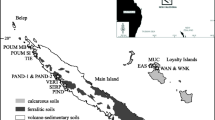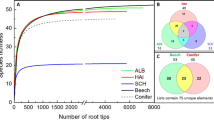Abstract
The distribution of ectomycorrhizas on Dryas octopetala L in grass heaths of the 450 km2 karst region known as the Burren in Western Ireland was examined in relation to soil factors and vegetation type. Ectomycorrhizas were identified or characterised from 56 soil cores from 30 sites, and the occurrence of each ectomycorrhizal (EM) type was quantified by estimating the total length of mycorrhizal tips of each type. Soil organic matter, total nitrogen, extractable phosphorus, pH and depth were the soil factors determined. In total, 24 EM types were recorded. The EM community of Dryas roots was significantly more species-rich in one vegetation type—Hyperico-Dryadetum—than in others (Arctostaphylo-Dryadetum or Asperulo-Seslerietum). Multiple linear regression analyses indicated that soil organic matter and soil depth explained a significant portion of the variation in EM abundance, while soil organic matter and extractable phosphorus explained a significant portion of the variation in EM diversity. Canonical correspondence analysis showed that some individual EM types (e.g. Craterellus lutescens, Cenococcum geophilum, Tomentella sp., Boletus sp.) exhibited distinct soil preferences, most markedly in relation to soil organic matter, which, in this analysis, was the main significant soil variable distinguishing the three vegetation types.




Similar content being viewed by others
References
Abuzinadah RA, Read DJ (1986) The role of proteins in the nitrogen nutrition of ectomycorrhizal fungi. I. Utilization of peptides and proteins by ectomycorrhizal fungi. New Phytol 103:481–493
Agerer R (1986) Studies on ectomycorrhizae. II. Introducing remarks on characterisation and identification. Mycotaxon 26:473–492
Biondini ME, Mielke PW, Berry KJ (1988) Data-dependent permutation techniques for the analysis of ecological data. Vegetatio 75:161–168
Bledsoe C, Klein P, Bliss LC (1990) A survey of mycorrhizal plants on Truelove Lowland, Devon Island, N.W.T., Canada. Can J Bot 68:1848–1856
Bremner JM, Mulvaney CS (1982) Nitrogen-total. In: Page AL, Miller RH, Keeney DR (eds) Methods of soil analysis. Part 2: chemical and biological properties. Agronomy Monographs No. 9. American Society of Agronomy; Soil Science Society of America, Madison, Wis., pp 595–624
Byrne E (1979) Chemical analysis of agricultural materials. An Foras Taluntais, Dublin
Conn C, Dighton J (2000) The influence of litter quality on mycorrhizal communities. Soil Biol Biochem 32:489–496
Danielson RM, Visser S (1989) Effects of forest soil acidification on ectomycorrhizal and vesicular-arbuscular mycorrhizal development. New Phytol 112:41–48
Fransson PMA, Taylor AFS, Finlay RD (2000) Effects of continuous optimal fertilization on belowground ectomycorrhizal community structure in a Norway spruce forest. Tree Physiol 20:599–606
Gardner JH, Malajczuk N (1984) Recolonisation by mycorrhizal fungi of rehabilitated bauxite mine sites in Western Australia. For Ecol Manag 24:27–42
Gehring CA, Theimer TC, Witham TC, Keim P (1998) Ectomycorrhizal fungal community structure of pinyon pines growing in two environmental extremes. Ecology 79:1562–1572
Goodman DM, Trofymow JA (1998) Distributions of ectomycorrhizas in micro-habitats in mature and old-growth stands of Douglas-fir on southeastern Vancouver Island. Soil Biol Biochem 30:2127–2138
Harrington T (1996) Observations on the macrofungi of Dryas communities in the Burren, western Ireland. Ir Nat J 25:157–192
Harrington TJ (2001) Macromycete diversity and ectomycorrhizal associations in Dryas heaths in the Burren. PhD Thesis, University College Dublin, National University of Ireland, Ireland
Harrington TJ (2003) Relationships between macrofungi and vegetation in the Burren. Biol Environ 103B:147–159
Harrington TJ, Mitchell DT (2002a) Characterization of Dryas octopetala ectomycorrhizas from limestone karst vegetation, western Ireland. Can J Bot 80:970–982
Harrington TJ, Mitchell DT (2002b) Colonization of root systems of Carex flacca and C. pilulifera by Cortinarius (Dermocybe) cinnamomeus. Mycol Res 106:452–459
Harrington TJ, Mitchell DT (2005) Ectomycorrhizas associated with a relict population of Dryas octopetala in the Burren, western Ireland. II. Composition, structure and temporal variation in the ectomycorrhizal community. Mycorrhiza (in press) DOI 10.1007/s00572-005-0348-3
Harvey AE, Jurgensen MF, Larsen MJ (1976) Distribution of ectomycorrhizae in a mature Douglas fir/larch forest in western Montana. For Sci 22:393–398
Harvey AE, Larsen M, Jurgensen MF (1979) Comparative distribution of ectomycorrhizae in soils of three western Montana forest habitat types. For Sci 25:350–358
Heck KL, van Belle G, Simberloff D (1975) Explicit calculation of the rarefaction diversity measurement and the determination of sufficient sample size. Ecology 56:1459–1461
Heijden EW van der, de Vries FW, Kuyper TW (1999) Mycorrhizal associations of Salix repens L. communities in succession of dunes ecosystems. I. Above-ground and below-ground views of ectomycorrhizal fungi in relation to soil chemistry. Can J Bot 77:1821–1832
Ivimey-Cook RB, Proctor MCF (1966) The plant communities of the Burren, Co. Clare. Proc R Ir Acad 64:211–301
Jeffrey DW (2003) Grassland and heath: a review and hypothesis to explain the distribution of Burren plant communities. Biol Environ 103B:111–124
Jonsson L, Dahlberg A, Nilsson M-C, Zackrisson O, Kårén O (1999) Ectomycorrhizal fungal communities in late-successional Swedish boreal forests, and their composition following wildfire. Mol Ecol 8:205–215
Kernaghan G (2001) Ectomycorrhizal fungi at tree line in the Canadian Rockies. II. Identification of ectomycorrhizae by anatomy and PCR. Mycorrhiza 10:217–229
Kernaghan G, Currah R (1998) Ectomycorrhizal fungi at tree line in the Canadian Rockies. Mycotaxon 69:39–80
Kernaghan G, Harper KA (2001) Community structure of ectomycorrhizal fungi across an alpine/subalpine ecotone. Ecography 24:181–188
Murphy J, Riley JP (1962) A modified single solution method for the determination of phosphate in natural waters. Anal Chim Acta 27:31–36
Shimwell DW (1971) Festuco-Brometea Br.-Bl. et R. Tx. 1943 in the British Isles: the phytogeography and phytosociology of limestone grasslands. Vegetatio 23:1–60
Tennant D (1975) A test of a modified line intersection method for measuring root length. J Appl Ecol 63:995–1001
ter Braak CJF, Šmilauer P (1998) CANOCO reference manual and user’s guide to Canoco for Windows. Software for canonical community ordination (version 4). Centre for Biometry Wageningen (Wageningen, NL) and Microcomputer Power, Ithaca, N.Y.
Tyler G (1985) Macrofungal flora of Swedish beech forest related to soil organic matter and acidity characteristics. For Ecol Manag 10:13–29
Villeneuve N, Grandtner MM, Fortin JA (1988) Frequency and diversity of ectomycorrhizal and saprophytic macrofungi in the Laurentide Mountains of Quebec. Can J Bot 67:2616–2629
Watts WA (1984) The Holocene vegetation of the Burren, western Ireland. In: Haworth EY, Lund JWG (eds) Lake sediments and environmental history. Leicester University Press, Leicester, UK
Yang G, Cha JY, Shibuya M, Yajima T, Takahashi K (1998) The occurrence and diversity of ectomycorrhizas of Larix kaempferi seedlings on a volcanic mountain in Japan. Mycol Res 102:1503–1508
Zar JH (1999) Biostatistical analysis, 4th edn. Prentice Hall, New Jersey
Acknowledgements
The assistance and advice of Andy Taylor, Anna Rosling and Roger Finlay (Department of Forest Mycology and Pathology, Swedish University of Agricultural Sciences, Uppsala, Sweden) are gratefully acknowledged.
Author information
Authors and Affiliations
Corresponding author
Rights and permissions
About this article
Cite this article
Harrington, T.J., Mitchell, D.T. Ectomycorrhizas associated with a relict population of Dryas octopetala in the Burren, western Ireland. I. Distribution of ectomycorrhizas in relation to vegetation and soil characteristics. Mycorrhiza 15, 425–433 (2005). https://doi.org/10.1007/s00572-005-0347-4
Received:
Accepted:
Published:
Issue Date:
DOI: https://doi.org/10.1007/s00572-005-0347-4




